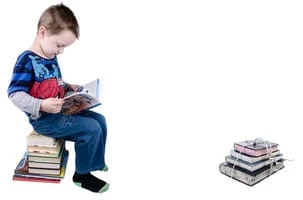Vision Therapy

When you stop to think about it, society places a premium on an efficient vision system. Schools and most occupations require increasing amounts of printed and computer information to be handled accurately and in shorter periods of time. Vision is also a major factor in sports, crafts, and other pastimes. The efficiency of our visual system directly affects how we collect and process information on a continual bases. Repetitive demands on the visual system tend to create problems in people with visual system deficiencies. Inefficient vision may cause an individual to slow down, be less accurate, experience excessive fatigue, or make errors. When these types of signs and symptoms appear, the individual's conscious attention to the process is required. This, in turn, may interfere with speed, accuracy, and comprehension of the visual task at hand. Many of these visual dysfunctions are effectively treated with vision therapy.
Vision - The Dominant Sense
Vision is a product of our inherited potentials, our past experiences, and current information. Efficient visual functioning enables us to understand the world around us better and to guide our actions accurately and quickly.
Vision is the dominant sense and is composed of three areas of function:
- Visual Pathway Integrity - This includes eye health, visual acuity, and refractive status.
- Visual Skills - The three major components are accommodation (eye focusing), binocular vision (eye teaming) and eye movements (eye tracking).
- Visual Information Processing - A combination of identification, discrimination, spatial awareness, and integration with other senses.

Learning to read requires efficient and finely tuned visual abilities. The eyes must team precisely, focus clearly, and track quickly and accurately across the page. These processes must be coordinated with the perceptual and memory aspects of vision, which in turn must combine with linguistic processing for comprehension. To provide reliable information, this must occur with precise timing.
Inefficient or poorly developed vision requires individuals to divide their attention between the task they are performing and the involved visual abilities. In doing so, some individuals have symptoms such as headaches, fatigue, eyestrain, and difficulty sustaining attention. Others may have an absence of symptoms simply due to the avoidance of visually demanding tasks due to the fear of failure.
What is Vision?
In order to understand Vision Therapy, you must understand vision. There's more to vision than just having 20/20 eyesight. Vision includes eyesight plus:
-
Binocular Vision - This is using both of our eyes together. Children who have binocular problems will often complain of letters or words moving as they read. These problems can also cause blurred or double vision and affect a child's reading speed and comprehension.
-
Eye Tracking (Ocular Motor) - When we read, we can only identify letters and words within our span of recognition. This is not more than 8 to 15 letter positions for most readers. In fact, even good readers do not average more than one word per fixation until the tenth grade. A fixation is when we pause our eyes to read. Because we do not see entire lines of words at a time, we have to move our eyes across a line of print. Dyslexic children have very poor eye tracking skills and will often have to reread numerous times. This is because they often lose their place easily during reading. These children will have to use their finger or a marker to keep their place when they read. Dr. Brecheen uses an instrument called an Visagraph to record children's eye movements when they read. This can give very valuable information about your child. It will tell if your child has poor eye tracking and loses his place easily, or if he has slow decoding skills. It will also record your child's reading speed and reading efficiency.
-
Visual Perception - This is the ability to understand what we see based on our past experiences. Perception problems can cause sloppy and disorganized printing and reversals of letters or words.
What is Vision Therapy?
Vision therapy is prescribed to treat diagnosed inefficiencies of the visual system that contribute to reading and learning disabilities. Effective therapy requires visual skills to be developed until they are integrated with other systems and become automatic, enabling individuals to achieve their full potential. The goals of a prescribed vision therapy treatment regimen are to achieve desired visual outcomes, alleviate the signs and symptoms, meet the patient's needs, and improve the patient's quality of life. Age is not a deterrent to the achievement of successful vision therapy outcomes.
Vision Therapy consists of the following:
- A regimented program of visual exercises designed to strengthen deficient areas of patient's vision
- Prescribed exercises to be routinely performed under doctor supervision
- In-office visits which are generally required once or twice a week
- In-office visits are complimented with procedures done at home between office visits
- Individualized to fit the specific visual needs of each patient
How we can help
The Brecheen Learning and Vison Center has activities that bring a child up to his age level in all perceptual areas. The required amount of time to achieve this is usually between 6-9 months.
Dr. Brecheen's vision therapy program is an in-clinic program. This means that your child will be given personal attention by a trained vision therapist who is also a classroom teacher. The therapy sessions are semi-private and last about one hour. You are then given activities to work with at home. All therapy students are re-evaluated after 21 sessions. The average child usually graduates from vision therapy after the second or third re-evaluation.
Click here for a list of commonly asked questions about vision therapy.
